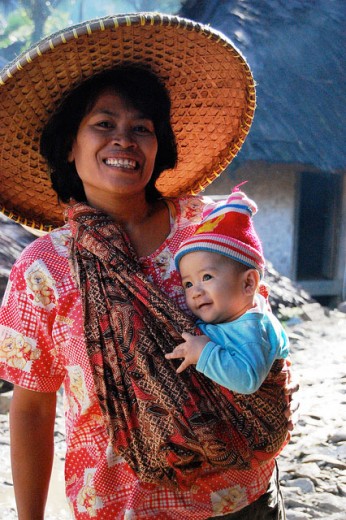Global Lens: Getting Back on Target for Proper Aid Distribution
Jurist Tan is the Project Manager for IPA-J-PAL's Effective Targeting of Anti-Poverty Programs project in Indonesia.
“What does the primary breadwinner in your household do?” the interviewer asked the applicant. That day, most of the applicants I observed answered, “Buruh tani,” meaning farm worker.
Photo Credit: Jurist Tan, IPA.
I was in the picturesque Sindanglaya village in West Java, Indonesia, monitoring the sign-up process for Program Keluarga Harapan (PKH), Indonesia’s nationwide cash transfer program for very poor households. That day, we were simultaneously piloting the same sign-up process in Makassar, the capital of the South Sulawesi province. In a stunning contrast to Sindanglaya’s green rice terraces and clear blue skies, Makassar boasts dozens of high rise buildings and a busy port. I suspect that in Makassar, when asked about the occupation of the primary breadwinner, more households answered “longshoreman” or “motorcycle taxi driver” than “farm worker.”
These different livelihoods provide a snapshot of Indonesia’s diversity. The country has 18,000 islands that span the length of the United States. Those islands are home to everything from villages to cities, rivers to tropical jungles, and rice fields to high-rise buildings. However, despite the vast range of geographical and economic conditions here, at the moment the country uses only one method to find the households that would receive aid programs like PKH: the tri-annual household asset survey. For this method, a group of surveyors ask local sub-village heads about whom they should survey; then, the surveyors visit the households and collect data on the assets each household has. Increasingly, the government is finding that the household survey works fine to identify poor households in some areas, but not in others. According to one estimate by the World Bank, in 2005 Indonesia’s cash transfers program mis-targeted 45% of its funds to non-poor households, while excluding 47% of the poor.[1]
Photo Credit: Jurist Tan, IPA.
The J-PAL/IPA team in Indonesia is working with the World Bank, the Indonesian Ministry of Social Affairs, and the Indonesian National Statistical Bureau to address this issue by testing two alternative targeting methods within PKH: a community-based method, where community members gather to discuss and rank the poorest households in their community, and self-targeting, where households are given a chance to apply for the program. Each treatment has potential advantages and drawbacks. For example, while the community-based method may tap into local knowledge not captured by the limited variables in an asset survey, there is a possibility of village elites diverting funds to their family and friends (a phenomenon known as elite capture). On the other hand, while the application process may discourage some non-poor households from applying, it may also be too arduous for the poorest of the poor.
In the first half of 2011, we tested the two targeting methods in 600 villages across Indonesia, hoping to capture a wide range of geographical and economic conditions: from urban areas to rural areas, from swamps to dry farmland, and from rice fields to rubber plantations. Now we are analyzing and comparing the results from both methods with those of the household survey method, which acted as the comparison group. The questions we are considering include: Do some targeting methods work better than others? And if so, which targeting method works best in which settings?
A sub-village head in Makassar once said to me, “We are grateful for the government’s aid programs, but we just wish they would give the money to the right people.” Through learning from the community-based and self-targeting methods, we hope we can offer some alternative options to help the government’s aid better reach the poorest households.
[1]Figures used the common PPP$2 per day poverty threshold. Obtained from The World Bank. 2006. “Making the New Indonesia Work for the Poor: Overview.” Washington D.C: The World Bank.
For more perspectives from Accra to Kolkata, check out the rest of the Global Lens series.












